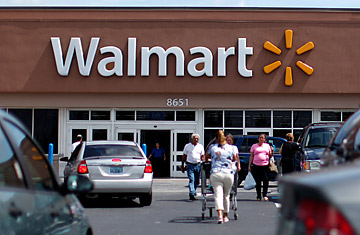
Customers at a Walmart in Miami
Walmart has rolled back its rollbacks. Earlier this year, the retailer tried to spark sluggish U.S. sales by lowering its prices — already bargains — even further. One analyst called it "an initiative that screams: Price! Price! Price!" These rollbacks, as they are known in Walmartspeak and in the company's advertising, were intended to overwhelm the shopper. In May, according to one shopping website, the price of a 40-oz. bottle of Heinz ketchup, which had been $2.42, was chopped to $1. Kraft mac and cheese, which had been going for $3.58, was reduced to $2.50. The rollback of a 50-oz. bottle of Tide laundry detergent, which was priced in the $7.48-$8.12 range, gave shoppers a $2.50 discount. Walmart expected a flood of customers to its stores, which would help lift the company's stock out of its rut and get Walmart rolling again.
Instead, cutting prices depressed sales, as shoppers took the bargains and ran. For the quarter ending July 31, Walmart's U.S. same-store sales fell 1.8%. The company's same-store sales have now fallen for five straight quarters. Of the rollback strategy, Bill Simon, the president and CEO of Walmart U.S., told investors at a September conference, "It did not do what we had hoped it would do. It did, however, drive price perception. It did not drive sales or traffic." As a result, Walmart rolled back the deeper discounts, and prices started inching upward this summer. According to a new report from J.P. Morgan, the price of a 31-item basket from a Walmart store in Virginia rose 2.7% in September alone. Walmart prices have jumped 5% since the start of the year and have been at their highest levels in the 21 months J.P. Morgan has tracked pricing data.
While Walmart may have stopped giving away the store, that doesn't mean customers will be facing sticker shock. "Walmart still stands for low prices," says David Strasser, equity analyst at Janney Montgomery Scott. Of the five retail-store chains J.P. Morgan studied (Walmart, Kroger, Safeway, Whole Foods and Harris Teeter, a 192-store chain in the Southeast), Walmart still had the lowest prices. (The Walmart basket cost $95.75 in September; Kroger, at second lowest, came in at $101.93.)
Still, the move signals a shift in strategy. Since the rollbacks didn't spur enough additional sales volume, Walmart needs to squeeze more revenues out of existing shoppers in order to satisfy analysts, institutional investors, shareholders and employees who are hungry for domestic growth. "Walmart is under unprecedented profit pressure," says retail consultant Burt Flickinger III, managing director for Strategic Resources Group. Walmart stock, which traded at $53.57 as of the Oct. 4 market close, is essentially flat for the year and 15% off its high before the September 2008 market crash. With economic conditions not as dour as they were in late 2008 and early 2009, now could be a good time to pull off a price increase.
The changes also reflect a shake-up in Walmart management. Under Project Impact, a strategy executed by former U.S. CEO Eduardo Castro-Wright, Walmart not only instituted more aggressive price-cutting but also moved to make its stores cleaner and better organized. Walmart's so-called Action Alleys, the often cluttered thoroughfares laden with promotional deals, were streamlined. But in order to make the aisles more breathable, Walmart reduced the number of items offered in the stores by about 15%.
It turned out, however, that shoppers really liked the many brand choices, so they went elsewhere for variety. In March, Walmart began restoring 300 brands and package sizes. In late June, Castro-Wright was transferred to global sourcing, and Simon, the chief operating officer for Walmart U.S., took over as CEO. Under Simon's direction, the price rollbacks were rescinded, even more items were stocked on the shelves and Action Alley was recluttered — though Simon insists the aisles will still be less cluttered than they were in the old days.
The company will meet with the investment community at its Bentonville, Ark., headquarters this week. There, executives might offer more hints about Walmart's direction. Overseas expansion remains robust. International sales rose 11% last quarter, Walmart added almost 5 million sq. ft. (465,000 sq m) of overseas retail space during that period and the company plans to keep expanding outside the U.S. Things are looking up in places like Brazil and China. Now Walmart hopes to see if higher prices will prop up America.
